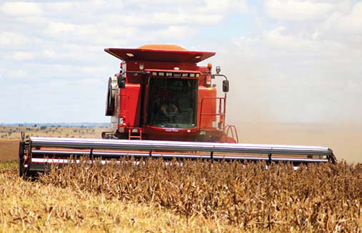How are Farmers Re-engaged With their Soils?
Through fear, finances, regulation or education?

There are countless examples throughout human history of entire civilisations which have crumbled as a result of the inadequacies of their soil management: Mesopotamia, Ancient Greece, the Roman Empire, European Colonies, Central America, and more recently the collapse of the American prairies. Yet we appear doomed to repeat these mistakes century after century. In an industry as old as agriculture new techniques are hard to come by. This poses challenges for our psyche which prefers new solutions to old problems. We therefore end up badging old techniques as new in order to pique interest. Take controlled traffic farming, a technique designed to reduce the compaction damage we have caused by movements of vehicles which get heavier and heavier with each purchase.
For at least a generation traditional soil husbandry has been far from fashionable. The rise of fertilisers and sprays has made it possible to prop up yields despite declining soil health. Further to this the ever increasing power and weight of machinery has meant that only being able to work soil when conditions are right has become an inconvenience of the past.
Machinery available now is bigger and stronger than ever allowing us to do what we like, when we like. I heard John Lewis-Stemple, a notable writer and an advocate for all things sustainable and organic, observe that one of the reasons farmers have become less connected to their surroundings, is due to enclosed cab tractors.
Now we don’t get wet when it rains or hear the birds chirp in the hedgerows; of course it does have practicalities like air conditioning during hot weather and protection from drift during spraying. Likewise if our only interaction with soil is from the comfy seat of a tractor rather than with our hands and a spade, it is no wonder we don’t realise when damage is being done or how our soil is changing over time. The dependency on inputs and technology is unfortunately combined with increased administrative burdens, which often results in more time farming from the office than the field.
Pressure from contracts more often than not worsens the habit of disregard for soil. If the contract says the crop must be harvested by X date and that day happens to be wet there is not a lot that many growers can do but pull on their wellies and make a mess. Further to this, where salad crops and vegetables are concerned, contracts often stipulate that organic manures cannot be used to maintain fertility of the soil. This is due to consumers not liking the inconvenience of washing their food before use; consequently not only compromising the health of the soil but also the quality of the produce. To further complicate matters, in recent years we have seen a rise in the amount of land rented under short term tenancy. Who then has the soil’s best interest at heart? The landowner who is receiving rent no matter the state of the soil, or the tenant who will not reap any of the long term benefits of taking care of it today?
So why seek soil enlightenment now? Professor Wilfred Otten concluded that “there is only a thin layer standing between humanity and extinction, and our salvation lies in the soil….
We are thinning this critical layer at a rate slow enough to prevent immediate anxiety in society but fast enough to threaten long term survival.” How many acres of top soil are washed every year by rain? Is this recognised by the farming community as a particularly awful incident? May be it passes most by without too much concern: just another rain storm with “a bit of brown water”. Even fairly significant soil loss does not cause anxiety when it is diffuse by nature.

For other sectors this anxiety is already more acute. Each time the rivers run red after rain there are negative impacts on tourism, fisheries, local housing growth and potable water supplies. But the impacts of our rivers not meeting the requirements of the Water Framework and Habitats Directives are not limited to off-farm. These failures hint at declining organic matter levels, increasing costs for cultivations and artificial inputs, inefficient grazing and an overarching decline in traditional soil husbandry at the expense of profitability and sustainability. But this transition has been gradual. Most people haven’t even realised it’s happened. Besides, technology is far sexier than soil. Worms and organic matter don’t make your neighbours crane their necks when they drive by.
The Government is not ignorant of the issue either. A Policy on introduction of more ambitious soil management requirements into cross compliance is needed. Those working proactively to improve their soil the arrival of more stringent regulations are of little consequence. For those pushing their soils hard with little understanding of its “health”, witnessing structure issues and runoff on a regular basis, this poses a significant threat to their basic payment. The latter group is exactly the audience the soil GAECs are aimed at, but without appropriate enforcement it seems these requirements will also fail to engage farmers with their soil.
Soil is not only a growing medium for the food we eat but a crucial tool in mitigating climate change. Meanwhile the media is plagued with negative press exposing the industry’s perceived shortcomings of “2 million tonnes of top soil degraded each year” and “only 100 harvests left”. But at a grass roots level - pardon the pun - there felt like a gathering of momentum in the level of interest in soil health. What approaches for reinvigorating a farmer’s interest had proven to be successful elsewhere in the world?
Conclusions
No single mechanism if implemented alone will reinvigorate interest in soil health. A combination of regulation, knowledge transfer and financial rewards is more likely to engage the broad range of farm type and farmer personalities.
Regulation must be enforced so that it can be, relied upon to address poor practice which impacts negatively on the environment. Its presence can encourage the adoption of innovative solutions which result in more resilient businesses.
Financial incentives may engage an audience but it can also create a mind-set of only following good practice if you are paid for it. Instead financial benefits should reward, or be a happy consequence of, good practice.
The role of facilitation is essential for effective knowledge transfer and farmer empowerment. Promotion of “leading” practice through discussion groups, peer-to peer, on farm events, and short videos will enhance the cascade of enthusiasm from early adopters.
Only those who have changed can explain how they overcame the barriers. Much resource can be wasted chasing the 20% who don’t willingly engage when much more can be achieved with the 80% who do. Resources and effort should be prioritised accordingly.
Recommendations for re-engaging farmers with their soil Research should focus on quantifying the benefits of healthy soils in order to equip those who engage with farmers with the tools to win over hearts, minds and wallets. This will also inform the wider landscape and societal benefits that agriculture provides and may identify innovative funding streams, for example ecosystem services. Researchers must utilise existing networks to disseminate relevant findings.
Legislators must proactively engage and consult the agricultural community over new regulations, especially the drivers and consequences in relation to their own business. The agricultural community must not shy away from taking ownership of the issues the regulations seek to address and ensure credit is given for improvements made. There is need for an independent soil health initiative to promote the benefits of a range of approaches rather than segment itself under one, e.g. holistic or organic, to ensure it can engage a broad audience.
Thread soil health principles across multiple streams of governmental policy rather than just agriculture. Distil and disseminate relevant research in a user-friendly accessible format. Engage the wider public over the importance of soil and its associated health benefits to ensure long term behaviour change of consumer habits and improve understanding of our farming systems. Those in charge of initiatives proactively engaging with farmers should develop their role as a Facilitator rather than considering themselves to be an Educator. Empowerment of leading/host farmers will allow for the cascade of enthusiasm to occur with ideas and practices shared peer to peer.
Recommendations for farmers wishing to reengage with their soil “As to methods there may be a million, but principles are few. The man who grasps the principles can successfully select his methods...” This quote from Ralph Waldo Emerson must be considered when addressing soil health issues. There is no ‘magic bullet’ product or practice that will cure degraded soils. Once the cause and effect of said degradation is understood methods can be chosen to correct it. Be mindful of what your personal barriers to change are so that if they are restricting progress you will be able to identify this and rectify it.
Change does not occur over the short term and support during the process is essential. Involving family and/or friends in the process establishes a valuable support network. Sir Isaac Newton used the phrase “Standing on the shoulders of giants” and this is recommended for those adopting new techniques. Learn from those who have already implemented them successfully; involvement with innovative groups and taking advantage of key alliance opportunities can ensure the transition is less challenging.
Think of soils as a bank account; whatever we take out with cultivations and cropping we need to replenish with grazing, manures, chopping straw, cover crops. Understand the cost-benefits of good soil health so that funding opportunities are a consequence not a driver of change.